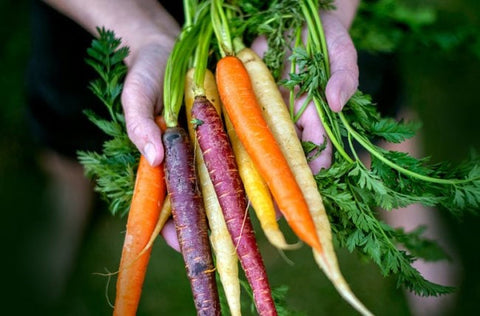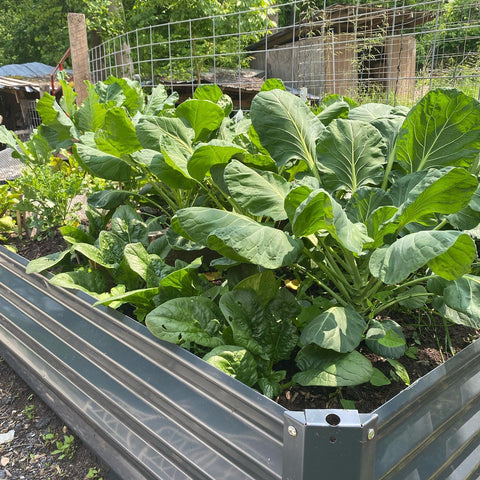In the realm of gardening, the vertical allure of climbing plants transforms the ordinary into the extraordinary, breathing life and vibrancy into your raised garden bed. This comprehensive blog delves into the enchanting world of climbing plants, celebrating their aesthetic charm and providing a curated list of climbing vegetables and fruits that will not only ascend but also enrich your garden bed with beauty and bounty.The following content also has some reference value for raised garden beds.

The Beauty of Growing Climbing Plants
1. Vertical Elegance:
Climbing plants possess a unique ability to introduce vertical elegance to your raised garden bed. Their upward growth creates a dynamic visual display, adding layers of beauty and dimension to your gardening space. Whether draped along trellises or winding up arbors, climbing plants elevate the aesthetic appeal of your garden.
2. Space Optimization:
In a raised garden bed where space is often at a premium, the vertical growth habit of climbing plants becomes a valuable asset. These plants efficiently use vertical space, allowing you to cultivate a diverse range of flora without overcrowding. This space optimization is particularly advantageous in smaller garden areas.
3. Natural Canopy and Shade:
The sprawling foliage of climbing plants creates a natural canopy that not only adds a touch of enchantment to your garden bed but also provides welcome shade. This lush greenery offers a cool retreat, making your raised garden an inviting haven for relaxation on warm days.
4. Seasonal Flourish:
Climbing plants contribute to a dynamic and ever-changing garden landscape. From the vibrant blooms of spring to the rich foliage of summer and the fiery hues of autumn, these plants undergo seasonal transformations that infuse your garden with a sense of continual vitality and beauty.
5. Blossoming Colors:
The blooms of climbing plants bring forth a kaleidoscope of colors, injecting vibrancy and joy into your garden bed. Whether it's the delicate pastels of climbing roses or the bold hues of clematis, these blossoms create a captivating visual spectacle that evolves throughout the growing season.
6. Wildlife Haven:
Climbing plants attract a variety of wildlife, from pollinators like bees and butterflies to birds seeking refuge. The presence of these plants fosters biodiversity, creating a harmonious ecosystem within your garden. Observing butterflies flitting among the blossoms or birds finding shelter among the vines adds to the beauty of the natural cycle.

15 Climbing Vegetables & Fruits for Your Raised Garden Bed
1. Cucumbers:
- Vertical Growth: Cucumbers exhibit a climbing habit, making them ideal for trellises or vertical structures in raised beds. Vertical growth not only saves space but also promotes straighter fruits and easier harvesting.
2. Tomatoes:
- Vertical Stakes: Many tomato varieties can be trained to climb vertical stakes or cages. Vertical growth enhances air circulation, reduces the risk of diseases, and facilitates the harvesting of ripe tomatoes.
3. Pole Beans:
- Upward Bound: Pole beans, such as runner beans or snap peas, are natural climbers. Growing them vertically saves ground space, encourages healthier plants, and makes harvesting a breeze.
4. Gourds:
- Climbing Frames: Gourds, including bottle gourds and birdhouse gourds, can be encouraged to climb frames or trellises. This not only adds decorative elements to your garden but also ensures well-formed gourds.
5. Melons:
- Vertical Trellising: Certain melon varieties, like cantaloupes and honeydews, can be grown vertically with proper trellising. This method saves space and prevents rotting by keeping the fruits off the ground.
6. Squash:
- Climbing Varieties: Climbing squash varieties, such as butternut squash or acorn squash, offer a space-saving solution. Vertical growth promotes healthier plants and aids in pest management.
7. Grapes:
- Arbor Ascendance: Growing grapes on arbors not only adds a touch of vineyard charm to your garden but also yields a bountiful harvest of sweet and juicy grapes. Grapes are well-suited for vertical gardening.
8. Passionfruit:
- Vertical Trellises: Passionfruit vines, with their exotic flowers and delectable fruits, bring a touch of tropical elegance. Training them to climb on trellises enhances the visual display and facilitates fruit harvesting.
9. Kiwi:
- Climbing Structures: Kiwi vines are vigorous climbers that thrive when given vertical support. Training kiwis to climb not only saves space but also ensures optimal sunlight exposure for fruit development.
10. Raspberries:
- Vertical Supports: Certain raspberry varieties, especially those with an upright growth habit, can be trained to climb with proper support. Growing raspberries vertically improves air circulation and facilitates berry harvesting.
11. Blackberries:
- Trellising Triumph: Blackberry bushes can be guided to climb trellises or supports. Vertical growth not only makes the berries more accessible but also contributes to a tidy and organized garden bed.
12. Cantaloupes:
- Hanging Harvest: Cantaloupes, when provided with vertical support, can produce hanging fruits. This method not only saves ground space but also ensures well-formed and easily reachable melons.
13. Peas:
- Climbing Structures: Peas, especially varieties like sugar snap peas, exhibit climbing tendencies. Growing them on vertical structures promotes healthier vines and simplifies the harvesting process.
14. Hops:
- Vertical Aromatics: Hops vines, traditionally known for their use in brewing, can be cultivated vertically on trellises. Vertical growth facilitates harvesting and enhances the aesthetic appeal of your garden.
15. Luffa:
- Trellis Elegance: Luffa, also known as sponge gourd, can be trained to climb trellises or vertical structures. This not only saves space but also ensures straight and well-formed luffas.
Tips for Growing Climbing Vegetables and Fruits in Raised Garden Beds
1. Sturdy Supports:
Invest in sturdy trellises, arbors, or vertical structures to support the weight of climbing plants, especially when bearing fruits. Ensure the supports are securely anchored to withstand the climbing load.
2. Proper Spacing:
Provide adequate spacing between climbing plants to allow for proper air circulation. This helps prevent diseases, encourages healthier growth, and facilitates easier harvesting.
3. Regular Pruning:
Practice regular pruning to control the growth of climbing plants. Removing excess foliage and spent vines not only keeps the plants tidy but also promotes better airflow and sunlight penetration.
4. Mulching:
Apply a layer of organic mulch around the base of climbing plants to retain soil moisture, suppress weeds, and regulate soil temperature. Mulching also contributes to overall soil health.
5. Watering Consistency:
Maintain consistent watering, especially during dry periods, to support the vigorous growth of climbing plants. Pay attention to the moisture needs of specific vegetables and fruits to ensure optimal development.
6. Training and Tying:
Train the vines to climb in the desired direction by gently guiding them along the support structures. Use soft ties or twine to secure vines to trellises, ensuring they have the necessary support as they grow.

Conclusion: A Vertical Symphony of Beauty and Bounty
As you embark on the journey of cultivating climbing vegetables and fruits in your raised garden bed, you're not just gardening; you're orchestrating a vertical symphony of beauty and bounty. The aesthetic charm of climbing plants, combined with the practical benefits of space-saving and efficient harvests, makes them an invaluable addition to your gardening repertoire. So, let your garden bed become a canvas for nature's ascension, where the beauty of climbing plants intertwines with the joy of a bountiful harvest, reaching new heights with every season.









